The Beastiary
Reptiles & Amphibians
Adder
A poisonous snake; there is only one mention of an adder in the entire series of books.
Etymology: Middle English, alteration (by false division of a naddre) of naddre, from Old English n[AE]dre; akin to Old High German nAtara adder, Latin natrix water snake; Date: 14th century;
"The common venomous viper (Vipera berus) of Europe; broadly: a terrestrial viper (family Viperidae); any of several North American snakes (as the hognose snakes) that are harmless but are popularly believed to be venomous." — Merriam-Webster Dictionary ©2003-2006
"Another was slain when an adder forced into his mouth tore its way free through the side of his face." — Marauders of Gor, page 26.
"In another case, somnolent and swollen, I saw a rare golden hith, a Gorean python whose body , even when unfed, it would be difficult for a full-grown man to encircle with his arms." — Priest-Kings of Gor, page 191.
Gorean Python
A snake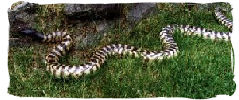 known also as the hith. See: "Hith."
known also as the hith. See: "Hith."
"After dark, various serpents seek out the road for its warmth, its stones retaining the sun's heat longer than the surrounding countryside. One such serpent was the huge, many-banded Gorean python, the hith." — Outlaw of Gor, page 26.
Hith
The banded, 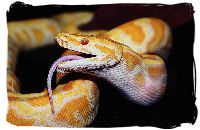 Gorean python. A rare type of this species is golden in hue.
Gorean python. A rare type of this species is golden in hue.
"After dark, various serpents seek out the road for its warmth, its stones retaining the sun's heat longer than the surrounding countryside. One such serpent was the huge, many-banded Gorean python, the hith." — Outlaw of Gor, page 26.
"In another case, somnolent and swollen, I saw a rare golden hith, a Gorean python whose body , even when unfed, it would be difficult for a full-grown man to encircle with his arms." — Priest-Kings of Gor, page 191.
Also in the ground zone are varieties of snake, such as the ost and hith, and numerous species of insects. — Explorers of Gor, page 311.
"In one cage, restlessly lifting its swaying head, there coiled a great, banded hith, Gor's most feared serpentine constrictor. It was native only to certain areas of the forest." — Captive of Gor, page 210.
Mamba
A large, predatory river tharlarion which inhabits the rivers of the rainforests inland of Schendi; they have long, log-like bodies, with short, powerful legs and a long snout and tail. Of interest to some, I have seen mention that "Mamba" is the Swahili word for "Alligator." This is not true. The Swahili word for "Alligator" is "Wa Nyanya." The word "Mamba" is actually of Zulu origin and refers to a highly poisonous snake found in Africa.
Etymology: Zulu im-amba;
"Any of several tropical and southern African venomous snakes of the genus Dendraspis related to the cobras but lacking a dilatable hood; especially: a southern African snake (D. angusticeps) that has a light or olive-green phase and a black phase, that attains in the latter phase a length of 12 feet, and that is dreaded because of its quickness and readiness to inflict its often fatal bite." — Merriam-Webster Dictionary ©2003-2006
"The word 'Mamba' in most of the river dialects does not refer to a venomous reptile as might be expected, given its meaning in English, but, interestingly, is applied rather generally to most types of predatory river tharlarion." — Explorers of Gor, page 393.
Marine Saurian
One of the many water lizards, 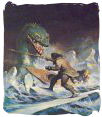 of varying sizes and degrees of danger to man, that inhabit the Thassa. Most probably, the tharlarions of the water, from the tiny tharlarion to the gigantic sea-tharlarion.
of varying sizes and degrees of danger to man, that inhabit the Thassa. Most probably, the tharlarions of the water, from the tiny tharlarion to the gigantic sea-tharlarion.
Etymology: New Latin Sauria, from New Latin saurus lizard, from Greek sauros; Date: circa 1829;
"Any of a suborder (Sauria) of reptiles including the lizards and in older classifications the crocodiles and various extinct forms (as the dinosaurs and ichthyosaurs) that resemble lizards." — Merriam-Webster Dictionary ©2002-2006
I had seen, yesterday, the long neck of a marine saurian lift from the waters of gleaming Thassa, It had a small head, and rows of small teeth. Its appendages were like broad paddles. Then it had lowered its head and disappeared. Such beasts, in spite of their frightening appearance, are apparently harmless to men. They can take only bits of garbage and small fish. Certain related species thrive on crustaceans found among aquatic flora. Further, such beasts are rare. Some sailors, reportedly, have never seen one. Far more common, and dangerous, are certain fishlike marine saurians, with long, toothed snouts; they are silent and aggressive, and sailors fear them as they do the long-bodied sharks." — Slave Girl of Gor, page 360.
"Suddenly I screamed with fear as something, long-snouted, with rows of tiny teeth, closed upon my leg. I began to scream with misery trying to hold the mast… I saw a round eye, lidded and lensed… Then the beast, suddenly, startling me, twisted, and swam a tight, angry circle, its long tail thrashing… A few feet from the raft, rolling lifeless in the water, was a grotesque marine saurian, fishlike but reptilian, more than twenty feet in length." — Slave Girl of Gor, pages 370-371.
Ost
A tiny snake, about twelve inches (12") long, bright orange in color; its venom causes extremely painful death within seconds; also known as the "common ost" as it is the most common variety on Gor. Other varieties include the Banded Ost and the Ushindi Ost.
"Also in the ground zone are varieties of snake, such as the ost and hith, and numerous species of insects." — Explorers of Gor, page 311.
"After dark, various serpents seek out the road for its warmth, its stones retaining the sun's heat longer than the surrounding countryside… One to be feared even more perhaps was the tiny ost, a venomous, brilliantly orange reptile little more than a foot in length, whose bite spelled an excruciating death within seconds." — Outlaw of Gor, page 26.
"I dreaded such creatures as the tiny ost, that diminutive, venomous reptile, orange, scarcely more than a few inches in length, that might lurk at one's very sandal and then, without provocation or warning, strike, its tiny fangs the prelude to excruciating torment, concluding only with sure death." — Outlaw of Gor, page 118.
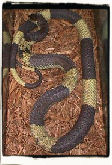 The Banded Ost is yellow-orange with black rings.
The Banded Ost is yellow-orange with black rings.
"The banded ost is a variety of ost, a small, customarily brilliantly orange Gorean reptile. It is exceedingly poisonous. The banded ost is yellowish orange and is marked with black rings." — Assassin of Gor, page 335.
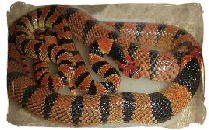 The Ushindi Ost is red with black rings.
The Ushindi Ost is red with black rings.
"I looked to the round, shallow, circular pit in the center of the room. It was about a foot deep. The poles supporting the sleeping platform were set within it. In the pit, his hands still clutching, fingernails bloody, at one of the round poles supporting the platform, lay an askari. His body was twisted horribly, and contorted. The flesh had turned a blackish orange and, in places, had broken open, the skin' peeling back like burned paper. A knife, fallen, lay near him in the pit About his body, small, nervous, sinuous, crawled tiny snakes, osts. Each of these, startlingly, had tied to it a thin string. There were eight such diminutive reptiles. The strings, fastened behind their heads, led up to a pole at the head of the sleeping platform, where they were tied. A woven basket hung, too, near the foot of the sleeping platform. The ost is usually an orange snake, but these were Ushindi osts, which are red with black stripes. Anatomically, and with respect to toxin, I am told they are almost identical to the common ost." — Explorers of Gor, page 239.
Often, ost venom is extracted and used in weapons such as fang rings. Death by ost venom is not a pleasant one.
"Saphrar was screaming insanely, and then to my astonishment, he bit into the Paravaci's forearm, sinking two golden upper canine teeth into the hooded man's flesh. The Paravaci suddenly cried out in uncanny fear and shuddered… I was scarcely aware of the brief whimpering of the Paravaci as, twisting and turning on the rug, biting at it, holding his arm, his flesh turning orange from ost venom, he writhed and died… I saw the contorted, now-orange, twisted, agonized face. Already it was like colored paper and peeling, as though lit and burned from the inside. There were drops of blood and sweat on it." — Nomads of Gor, page 318.
The small man held up a tiny packet. "This," he said, "is the poison, a powder prepared from the venom of the ost." I shuddered. Death by ost venom is among the most hideous of deaths. — Captive of Gor, page 357.
Salamander
The salamanders mentioned in the books were those that inhabited the brine pits of Klima. As with all creatures who live without any sunlight, these creatures have evolved to be white and blind, with long bodies and long stemlike legs. A slow metabolism allows these creatures to remain dormant for long periods of time. As with lelts, they have fernlike filaments attached to the sides of their heads. However, these filaments act as a gill system for the salamander.
"Any member of a group of about 400 species of amphibians that have tails and that constitute the order Caudata. The order comprises 10 families, among which are newts and salamanders proper
(family Salamandridae) as well as hellbenders , mud puppies, and lungless salamanders. They most commonly occur in freshwater and damp woodlands, principally in temperate regions of the Northern Hemisphere. Salamanders are generally short-bodied, four-legged, moist-skinned animals, about 10 to 15 cm (4 to 6 inches) long. They are often boldly patterned or brightly coloured. The largest of the order is the Chinese giant salamander, Andrias davidianus, which grows to 1.5 m (5 feet) in length. Typical salamanders undergo a larval stage that lasts for a period of a few days to several years. Larval forms have external gills and teeth in both jaws and lack eyelids. These and other larval features may persist into sexual maturity-a condition known as neoteny. A mud puppy (Necturus maculosus) of eastern North America and the axolotl (Ambystoma mexicanum) of central Mexico are common species that exhibit this phenomenon.
Salamanders feed on insects, worms, snails, and other small animals, including members of their own species. Like other amphibians, they absorb water through their skins, and they require a moist habitat. In regions where the temperature goes below freezing, they often hibernate. Most adult salamanders hide by day and feed by night. Some remain hidden underground until the breeding season, or they may emerge only when levels of moisture and temperature are appropriate. Many species, especially in the family Plethodontidae, are strictly terrestrial and avoid ponds and streams. Fertilization in primitive forms (suborder Cryptobranchoidea) is external. In higher forms, fertilization is usually internal; males of such forms often produce a spermatophore, or sperm case, which the female takes into her body through the cloacal opening. Breeding often occurs in the water, but certain members of the Salamandridae and most species of the Plethodontidae families breed on land." — Encyclopaedia Britannica ©2002-2006
"Among the lelts, too, were, here and there, tiny salamanders, they, too, white and blind. Like the lelts, they were, for their size, long-bodied,
were capable of long periods of dormancy and possessed a slow metabolism, useful in an environment in which food is not plentiful. Unlike the lelts they had long, stemlike legs. At first I had taken them for lelts, skittering about the rafts, even to the fernlike filaments at the sides of their head, but these filaments, in the case of the salamanders, interestingly, are not vibration receptors but feather gills, an external gill system. This system, common in the developing animal generally, is retained even by the adult salamanders, who are, in this environment, permanently gilled… The feather gills of the salamanders, it seems, allow them to hunt the same areas as the lelts for the same prey, the vibration effects of these organs being similar, without frightening them away, thus disturbing the water and alerting possible prey. They often hunt the same areas. Although this form of salamander possesses a lateral-line set of vibration receptors, like the lelt, it lacks the craneal receptors and its lateral-line receptors do not have the sensitivity of the lelt's. Following the lelt, not disturbing it, often helps the salamander find prey. On the other hand, the salamander, by means of its legs and feet, can dislodge prey inaccessible to the lelt. The length of the stemlike legs of the salamander, incidentally, help it in stalking in the water. It takes little prey while swimming freely. The long legs cause little water vibration. Further, they enable the animal to move efficiently, covering large areas without considerable metabolic cost. In a blind environment, where food is scarce, energy conservation is essential. The long, narrow legs also lift the salamander's head and body from the floor, enabling it, with its sensors, to scan a greater area for prey." — Tribesmen of Gor, pages 247-248.
Tharlarion
One of several types of large reptiles, most varieties being carnivorous, though a few varieties are herbivorous, some of which are domesticated; some varities live on land, while others live in water. The fat of the tharlarion is rendered to provide lamp oil. They do not make cute, 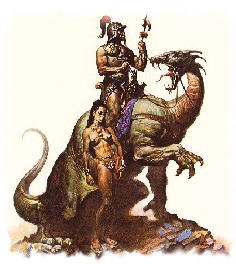 playful pets, although there are species that have been domesticated. Several types of Tharlarion are found on Gor, from the herbivorous draft beasts to the agile riding beasts to the tyrants of the marshes (Marsh Tharlarion) and the sea (Sea Tharlarion), down to the tiny water variety (Water Tharlarion). See also "Mamba."
playful pets, although there are species that have been domesticated. Several types of Tharlarion are found on Gor, from the herbivorous draft beasts to the agile riding beasts to the tyrants of the marshes (Marsh Tharlarion) and the sea (Sea Tharlarion), down to the tiny water variety (Water Tharlarion). See also "Mamba."
"Scarcely had she broken into the clearing, splashing through the shallow greenish waters near us, than the fearsome head of a wild tharlarion poked through the reeds, its round, shining eyes gleaming with excitement, its vast arc of a mouth slung open." — Tarnsman of Gor, page 84.
"Upon occasion, and it had happened early in Se'Kara this year, the arena is flooded and a sea fight is staged, the waters for the occasion being filled with a variety of unpleasant sea life, water tharlarion, Vosk turtles, and the nine gilled Gorean shark, the latter brought in tanks on river barges up the Vosk, to be then transported in tanks on wagons across the margin of desolation to Ar for the event." — Assassin of Gor, page 190.
"Now this," Saphrar the merchant was telling me, "is the braised liver of the blue, four-spired Cosian wingfish." This fish is a tiny, delicate fish, blue, about the size of a tarn disk when curled in one's hand; it has three or four slender spines in its dorsal fin, which are poisonous; it is capable of hurling itself from the water and, for brief distances, on its stiff pectoral fins, gliding through the air, usually to evade the smaller sea-tharlarions, which seem to be immune to the poison of the spines. — Nomads of Gor, page 84.
"To my right, some two or three feet under the water, I saw the sudden, rolling yellowish flash of the slatted belly of a water tharlarion, turning as it made its swift strike, probably a Vosk carp or marsh turtle. Immediately following I saw the water seem to glitter for a moment, a rain of yellowish streaks beneath the surface, in the wake of water tharlarion, doubtless its swarm of scavengers, tiny water tharlarion, about six inches long, little more than teeth and tail." — Raiders of Gor, page 1.
"Not only must they fear the march sharks and the carnivorous eels which frequent the lower delta, not to mention the various species of aggressive water tharlarion and the winged, monstrous, hissing, predatory UI, but they must fear, perhaps most of all, men, and of these, most of all, the men of Port Kar." — Raiders of Gor, page 8 .
"It is dangerous to enter the water to make a tether fast because of the predators that frequent the swamp, but several men do so at a time, once man making fast the tether and the others, with him beneath the surface, protecting him with marsh spears, or pounding on metal pieces or wooden rods to drive away, or at least to disconcert and confuse, too inquisitive, undesired visitors, such as the water tharlarion or the long-bodied, nine-gilled marsh shark." — Raiders of Gor, page 13.
"My leg slipped from the island into the water and suddenly a tiny tharlarion struck it, seizing his bit of flesh and backing, tail whipping, away. My leg was out of the water, but now the water seemed yellow with the flashing bodies of tiny tharlarion, and beyond them, I heard the hoarse grunting of the great marsh tharlarion, some of which grow to be more than thirty feet in length, weighing more than half a hundred men." — Raiders of Gor, page 58.
Turtle
Any of a number 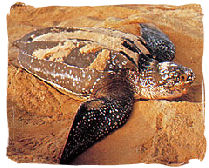 of shelled reptiles found in the waters of Gor; some varieties are small, while others are large and carnivorous.
of shelled reptiles found in the waters of Gor; some varieties are small, while others are large and carnivorous.
Etymology: modification of French tortue, from Late Latin tartarucha, feminine of tartaruchus of Tartarus, from Greek tartarouchos, from Tartaros Tartarus; Date: 1657:
"Any of an order (Testudines) of terrestrial, freshwater, and marine reptiles that have a toothless horny beak and a shell of bony dermal plates usually covered with horny shields enclosing the trunk and into which the head, limbs, and tail usually may be withdrawn." — Merriam-Webster Dictionary ©2002-2006
Any member of the Chelonia, an ancient order of reptiles chiefly characterized by a shell that encloses the vital organs of the body and more or less protects the head and limbs. The protective shell, to which the evolutionary success of turtles is largely attributed, is a casing of bone covered by horny shields. Plates of bone are fused with ribs, vertebrae, and elements of shoulder and hip girdles. There are many shell variations and modifications from family to family, some of them extreme. 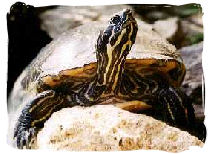 At its highest development, the shell is not only surprisingly strong but also completely protective.
At its highest development, the shell is not only surprisingly strong but also completely protective.
Turtles run the gamut in size. The Atlantic leatherback (Dermochelys coriacea), largest of living kinds, may weigh more than 680 kilograms (1,500 pounds) and measure 3.7 metres (12 feet) from the tip of one front flipper to that of the other. An extinct marine giant, Archelon, of the family Protostegidae, was probably much larger, and an extinct land turtle of Asia (Colossochelys atlas) had a shell 2.1 metres (seven feet) long. The largest living tortoises may weigh more than 225 kilograms (500 pounds). At the opposite extreme, the adults of some species weigh less than a pound and have a shell less than five inches long. The shell length of most adult turtles falls between five and 15 inches. — Encyclopaedia Britannica ©2002-2006
The Hook-Beak Turtle is a large, carnivorous turtle found in the Vosk river.
"It was far more likely that one of the water lizards of the Vosk or one of the great hook-beaked turtles of the river would seize my body and drag it and the frame under the water, destroying me in the mud below." — Tarnsman of Gor, page 139.
The Marsh Turtle 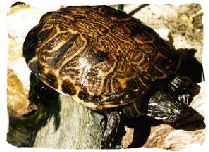 is a turtle which lives in the marshes of Gor.
is a turtle which lives in the marshes of Gor.
"To my right, some two or three feet under the water, I saw the sudden, rolling yellowish flash of the slatted belly of a water tharlarion, turning as it made its swift strike, probably a Vosk carp or marsh turtle." — Raiders of Gor, page 1.
The Vosk Turtle is one of several varieties of turtle native to the Vosk, some of which are very large and carnivorous.
"It might, too, be a Vosk turtle. Some of them are gigantic, almost impossible to kill, persistent, carnivorous." — Nomads of Gor, page 204.
"Upon occasion, and it had happened early in Se'Kara this year, the arena is flooded and a sea fight is staged, the waters for the occasion being filled with a variety of unpleasant sea life, water tharlarion, Vosk turtles, and the nine gilled Gorean shark, the latter brought in tanks on river barges up the Vosk, to be then transported in tanks on wagons across the margin of desolation to Ar for the event." — Assassin of Gor, page 190.
Ul
A gigantic toothed 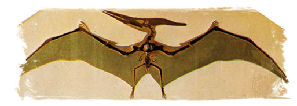 winged lizard, carnivorous. A pterodactyl of prehistoric Earth.
winged lizard, carnivorous. A pterodactyl of prehistoric Earth.
"Also, at night, crossing the bright disks of Gor's three moons might occasionally be seen the silent, predatory shadow of the ul, a giant pterodactyl ranging far from its native swamps in the delta of the Vosk." — Outlaw of Gor, page 26.
"I saw an UI, the winged tharlarion, high overhead, beating its lonely way eastward over the marsh." — Raiders of Gor, page 61.
"Only one creature in the marshes dares to outline itself against the sky, the predatory Ul, the winged tharlarion." Raiders of Gor, page 1.
"Not only must they fear the march sharks and the carnivorous eels which frequent the lower delta, not to mention the various species of aggressive water tharlarion and the winged, monstrous, hissing, predatory UI, but they must fear, perhaps most of all, men, and of these, most of all, the men of Port Kar." — Raiders of Gor, page 8 .
"I saw an UI, the winged tharlarion, high overhead, beating its lonely way eastward over the marsh." — Raiders of Gor, page 61 .
"High overhead, passing, I heard the squeals of four UIs, beating their way eastward on webbed, scaled wings." — Raiders of Gor, page 77.
Water Lizards
Tiny lizards that live in the Vosk; they live on carrion. Probably the tiny water tharlarion. See also: "Marine Saurian."
"About its flanks, as it settled into the mud, there was a stirring in the water, and I realized the small water lizards of the swamp forest were engaged in their grisly work.. — Tarnsman of Gor, page 85.
"Idly, with repulsion, I watched the body of the tharlarion in the swamp. As the water lizards had fed, the carcass, lightened, had shifted position, rolling in the water. Now, in a matter of minutes, the skeleton was visible, picked almost clean, the bones gleaming except where small lizards skittered about on them, seeking a last particle of flesh." — Tarnsman of Gor, page 86.
"I knew that I would not, some days hence, reach the delta of the Vosk and the cities in the delta except perhaps as a bound corpse, withered by exposure and the lack of water. Indeed, it was unlikely my body would reach the delta at all. It was far more likely that one of the water lizards of the Vosk or one of the great hook-beaked turtles of the river would seize my body and drag it and the frame under the water, destroying me in the mud below." — Tarnsman of Gor, page 139.
Winged Tharlarion
Reference Tarl Cabot made to the great flying lizard, the Ul. See: "Ul."
"I saw an UI, the winged tharlarion, high overhead, beating its lonely way eastward over the marsh." — Raiders of Gor, page 61 .
![]()
Special Note
Because of the differences in publishing the books, depending upon whether published in the U.S. or Europe, depending upon whether a first publishing or a Masquerade Books release, page numbers will often vary. All of my quotes are from original, first-printing U.S. publications (see The Books page for a listing of publishers and dates) with the exception of the following books:
- Tarnsman of Gor (2nd Printing, Balantine)
- Outlaw of Gor (11th Printing, Balantine)
- Priest-Kings of Gor (2nd Printing, Balantine)
- Assassin of Gor (10th Printing, Balantine)
- Raiders of Gor (15th Printing, Balantine)
- Captive of Gor (3rd Printing, Balantine)
Disclaimer
These pages are not written for any specific home, but rather as informational pages for those not able to get ahold of the books and read them yourself. Opinions and commentaries are strictly my own personal views, therefore, if you don't like what you are reading — then don't. The information in these pages is realistic to what is found within the books. Many sites have added information, assuming the existences of certain products and practices, such as willowbark and agrimony for healing, and travel to earth and back for the collection of goods. I've explored the books, the flora, the fauna, and the beasts, and have compiled from those mentioned, the probabilities of certain practices, and what vegetation mentioned in the books is suitable for healing purposes, as well as given practicalities to other sorts of roleplaying assumptions.